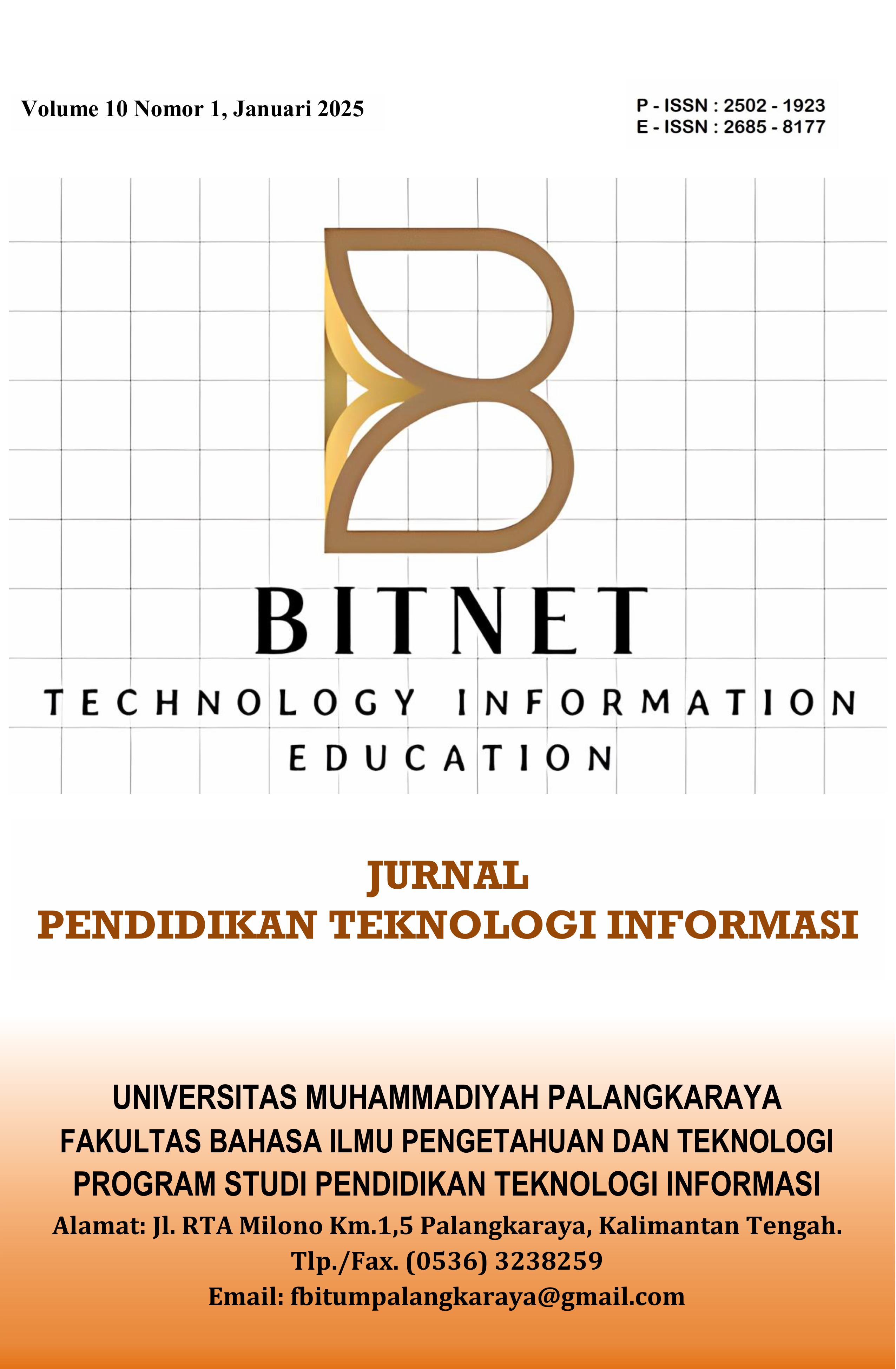Analysis Of ICT Laboratory Management Through SOP Implementation (Comparative Study at Karsa Mulya Vocational School and MAN Palangka Raya City)
DOI:
https://doi.org/10.33084/bitnet.v9i2.7582Abstract
Information and Communication Technology (ICT) facilities are a crucial component in supporting learning activities in schools. The implementation of effective Standard Operating Procedures (SOPs) is the key to ensuring efficient and orderly management of ICT laboratories, as well as ensuring the sustainability of facility use (Astriyani et al., 2024). This study aims to analyze the management of Information and Communication Technology (ICT) laboratories at SMK Karsa Mulya and MAN Palangka Raya City through the implementation of Standard Operating Procedures (SOPs). This study uses a qualitative descriptive method with a comparative case study approach. Data collection was carried out through observation, interviews, and documentation. The results of the study show that both schools have implemented SOPs in managing ICT laboratories, but there are differences in the scope and level of implementation. These differences are influenced by several factors, such as management support, personnel awareness, and resource availability. This study concludes that consistent implementation of SOPs can improve the effectiveness and efficiency of ICT laboratory management. This study provides recommendations for other schools to develop and implement comprehensive SOPs in managing ICT laboratories.
Downloads
References
Abrori, M., & Muali, C. (2020). Improving the Quality of Human Resources Through
The Principal's Leadership Role.JUMPA: Journal of Educational Management, 1(2). https://doi.org/10.33650/jumpa.v1i2.1200
Ali, MM, Hariyati, T., Pratiwi, MY, & Afifah, S. (2022). Research Methodology
Quantitative and its Application in Research.Education Journal.2022,2(2), 1– 6.
Astriyani, N., Akbar, GG, & Masripah, M. (2024). Influence of Policy Implementation Information and Communication Technology-Based Learning on Teacher Performance to Achieve Student Learning Achievement.Academic Treasures,
–50. In, S., Sultan, SMK, & Tebuireng, A. (2024).INCREASING CREATIVITY
LEARNING.2(4), 436–450.
Fikri, M. (2020). Basic Concepts of Educational Management & The Role of Operational Standards Procedure (SOP).Basic Concepts of Educational Management & The Role of Standard Operating Procedures (SOP),24, 1–18.
Husaeni, F., Sulistiyowati, N., & Rizal, A. (2018). Evaluation of Asset Management
Computer Laboratory Using Iso/Iec 27001 Standard.TAM (Technology Acceptance Model) Journal,9(2), 101–105.
Husna, NN, Naomi Tosani, & Neny Afridayanti. (2022). Optimization of Implementation Occupational Safety and Health in the Laboratory.CREATIVE: Indonesian Community Service Journal,2(4), 70–78. https://doi.org/10.55606/ kreatif.v2i4.730
Khalik, M., & Cahyaningrum, V. (2022). Learning Media and ICT. InJakarta: Our Writing Foundation(Vol. 5, Issue 3).
Khafid, MA, & Fahmi, I. (2022). Computer Laboratory Management in
Supporting the Learning Process at the Nihayatul Amal Purwasari Karawang Middle School (MTS).Scientific Journal of Educational Vehicle,8(20), 387–397. https://doi.org/10.5281/zenodo.7243130.
Mardianto, Kuat, T., & Muchlas. (2023). Development of Problem-Based Learning Methods Project Using Open Source Tutorials to Foster Learning Independence in Vocational High Schools.Tambusai Education Journal,7(3), 22769– 22779.
Mardizal, J., Rifwan, F., & Haq, S. (2024).Laboratory and Workshop Work Management.
Eureka Media Script.
Misdarpon, D., & Fatori, M. (2013). Occupational Safety and Health.Directorate General of Primary and Secondary Education Management, Ministry of Education and Culture,1, 1–107.
Ruhansih, DS (2017). EFFECTIVENESS OF THEISTIC GUIDANCE STRATEGY FOR DEVELOPMENT OF ADOLESCENT RELIGIOSITY (Quasi-Experimental Research on Grade X Students of SMA Nugraha Bandung in the 2014/2015 Academic Year).QUANTA: Journal of Guidance and Counseling Studies in Education,1(1), 1–10. https://doi.org/10.22460/q.v1i1p1-10.497
Solichin, A., & Painem, P. (2022). Identification of Potential Risks in the Laboratory Budi Luhur University Computer Uses the Hazard Identification, Risk Assessment and Risk Control (Hirarc) Method.Jukung (Environmental Engineering Journal), 8(2), 95–109. https://doi.org/10.20527/jukung.v8i2.14914.
Suslistya, V., & Mahadewi, G. (2023). Laboratory Management as a Step Improving the Quality of Natural Science Practical Implementation. SEARCH: ScienceEducationResearchJournal,1(2),1–13. https://doi.org/10.47945/search.v1i2.1247
Ulya, NH (2024).IMPROVING STUDENT ACHIEVEMENT IN ACADEMIC FIELDS
AT MTs SALAFIYAH SYAFI 'IYAH TEBUIRENG.2(4), 646–661.
Wijaya, K., Niswah, C., & Rohman, A. (2024). Implementation of Laboratory Maintenance Computer of SMAN 21 Palembang.Journal of Law, Administration, and Social Science,4(3), 472–478. https://doi.org/10.54957/jolas.v4i3.825
Downloads
Published
How to Cite
Issue
Section
License
Copyright (c) 2025 Athariq Maulana

This work is licensed under a Creative Commons Attribution-ShareAlike 4.0 International License.
All rights reserved. This publication may be reproduced, stored in a retrieval system, or transmitted in any form or by any means, electronic, mechanical, photocopying, recording.

